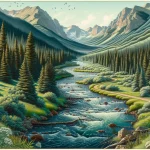Traversing over 11,000 feet through the heart of the Front Range, this byway takes travelers from the mining town charm of Georgetown to the alpine forests and peaks surrounding Grant along a route forged in the late 1800s.
In This Article
With so much to experience across Clear Creek County and Park County, planning is essential. This guide covers everything you need to know to plan your perfect road trip along one of Colorado’s cherished scenic highways.
TL;DR
- The historic byway winds 25 miles over Guanella Pass between Georgetown and Grant.
- Offers stunning Rocky Mountain scenery through the Front Range and opportunities for hiking, camping, fishing, and winter sports.
- Steeped in mining and railroad history with historic towns and relics along the route.
- Seasonal access with winter snow closures-check conditions and traction requirements.
- Plan your journey carefully accounting for high altitude, weather, seasonal closures, and road safety.
Captivating Mountain Scenery and Landscapes
As you begin the climb up Guanella Pass from Georgetown, the rocky crags of the Front Range rise sharply around you. The byway hugs sheer cliff walls, wraps around mountain basins, and reveals one breathtaking vista after another.
Towering 14,000-foot peaks dominate the landscape, including the distinctive summit of Mount Bierstadt. Lush aspen groves shimmer golden in the fall, while ice-blue lakes dotted with fir trees glisten below. Stop at one of the many pullouts to truly soak in the sweeping alpine panoramas-from the rugged Sawtooth Ridge to the peaks of the Mount Evans Wilderness.
As you near the summit, the views expand in every direction-a sea of mountains and valleys as far as the eye can see. The terrain transforms again on the descent towards Grant, blanketed with evergreen forest. Watch for bighorn sheep grazing along the roadside with pikas and marmots darting between the rocks.
Rich History in the Shadows of the Peaks
Guanella Pass has long attracted adventurers and opportunists alike for its mineral riches and natural bounty. The Ute tribes traversed these lands for generations before prospectors arrived hoping to strike it rich in the Colorado Gold Rush. Remnants of old mines and equipment still dot the mountainsides today.
The pass itself opened as a wagon trail in 1862 as an extension of the Mount Vernon road connecting the mining hub of Georgetown to settlements like Grant. Wagon drivers traversed the rugged route for decades before it was converted to an auto stagecoach road in 1920.
As you travel the byway today, glimpses of this frontier past appear at every turn. Visit Georgetown’s Victorian storefronts before stopping at the remains of Silverdale, one of the many ghost towns now quietly abandoned along Guanella Pass.
Year-Round Recreation from Hiking to Skiing
From hiking to fishing to snowmobiling, the recreational opportunities along Guanella Pass Road are endless. The byway provides easy access to over 50 miles of hiking and backpacking trails, ranging from short nature walks to multi-day excursions into remote wilderness. Camping options also abound, with developed campgrounds and backcountry sites catering to tent campers and RVers alike.
Anglers delight in the cold, clear waters of Clear Lake, Silver Dollar Lake, and Naylor Lake. Ice climbers test their mettle on frozen waterfalls while snowshoers and cross-country skiers explore the hushed winter landscape in areas like the Geneva Basin Ski Area. Once the snow melts, cyclists and motorcyclists alike flock to the road to challenge their endurance at high altitudes.
With stunning scenery, historic sites, and unlimited outdoor adventure, Guanella Pass Scenic Byway has rightfully earned its reputation as one of Colorado’s premier drives.
Essential Planning Tips Before You Go
At over 11,000 feet, Guanella Pass presents unique road trip considerations with its extreme elevations and mountain weather. While a journey along the byway is achievable for most, careful planning and preparation are required.
Know Before You Go
Check road conditions and weather forecasts from reliable sources. Snow, ice, and rockslides can close the pass for extended periods from fall through spring. Confirm the byway is open and ensure your vehicle has appropriate tires and traction equipment for any conditions.
Prepare for High Elevation
The extreme altitudes along Guanella Pass can induce altitude sickness, especially in visitors new to the region. Stay well hydrated, limit alcohol, and be alert for symptoms. Descend and seek medical attention if experiencing severe headaches, nausea, or shortness of breath.
Watch the Weather
The mountain weather changes rapidly and summer thunderstorms can develop quickly. Dress in layers and avoid exposed peaks and ridges if storms approach. Be prepared to delay travel if conditions deteriorate.
Know Where You Are
Sections of the byway lack cell service and GPS can be unreliable in the mountains. Carry offline maps and know your route and location in case of emergency. Share your plans with someone before departing.
With proper preparation and backup plans for changing conditions, a scenic drive over Guanella Pass promises to be an unforgettable Colorado adventure accessible to most.
Seasonal Guide to Guanella Pass Byway
Guanella Pass offers spectacular scenery and recreation all year long if you plan accordingly for the season. Here’s an overview of what to expect by season:
Summer Adventures Under Blue Skies
With long sunny days and wildflowers in bloom, summer showcases Guanella Pass at its very best. Visitors flock to hike through colorful alpine meadows and cast lines for native cutthroat trout in the clear mountain streams. Cool off by camping in Guanella Pass Campground below the soaring peaks or challenge your endurance by pedaling the byway on two wheels. Just be prepared for afternoon thunderstorms typical of Colorado’s high country during summer.
- When to Visit: June – September
- What to Expect: Warm, sunny days and cool nights with occasional afternoon thunderstorms. All facilities and services are open.
- Top Activities: Hiking, camping, fishing, scenic driving, motorcycle touring, mountain biking, wildlife viewing.
Fall Foliage and Festivals
Autumn in the Rocky Mountains is a sight to behold, with vibrant golden aspen groves flanking dark green pines. Crisp air and cold nights hint of winter’s approach but days remain mild enough for outdoor exploration. Enjoy the colorful foliage display on hikes through the Pike National Forest before the snow flies.
- When to Visit: September – October
- What to Expect: Cooling temps, fall foliage, possible early snowstorms.
- Top Activities: Leaf peeping, hiking, camping, fishing, festivals.
Winter Wonderland Adventures
Once the snow starts falling, the high country transforms into a frozen winter wonderland. The byway itself closes with the first heavy snows, typically by mid-November. For experienced winter recreationists, snowmobile access along the pass provides opportunities for backcountry skiing and snowshoeing. Check conditions and avalanche forecasts carefully before embarking into remote terrain in winter with proper gear and training.
- When to Visit: November – May
- What to Expect: Heavy snowfall, high avalanche danger, extreme cold.
- Top Activities: Snowmobiling, snowshoeing, cross-country skiing.
Spring Thaw and Wildflower Watch
As the winter snowpack starts melting in spring, access over mountain passes remains limited due to mud and runoff. Once cleared and dried out, Guanella Pass reopens to visitors-usually by early June. Time your trip to catch fields of colorful wildflowers blooming as the mountains come back to life. Be prepared for variable spring mountain weather, dressing in layers during this shoulder season.
- When to Visit: May – June
- What to Expect: Unpredictable weather, muddy conditions, spring wildflowers.
- Top Activities: Hiking, fishing, scenic driving.
Insider’s Guide to Navigating Guanella Pass
At 25 miles long reaching altitudes over 11,000 feet, conquering Guanella Pass is no easy feat. Here are some insider tips for navigating your journey:
Take It Slow
Between narrow lanes, blind curves, and steep grades, Guanella Pass is not the place for speed. Allow ample time to drive the byway safely, pulling over frequently to allow traffic to pass.
Use Lower Gears
For manual transmission vehicles, use lower gears while descending to control speed without riding brakes. The constant steep grades can cause overheated and failed brakes if not downshifting properly.
Watch for Wildlife
Deer, bighorn sheep, and even moose frequently cross or graze along the byway. Slow down and give wildlife plenty of space, especially at dawn and dusk when they’re most active.
Stay on Pavement
While dirt roads and trails branch off the main byway, stay on paved sections unless properly equipped for primitive backcountry travel with 4WD/high clearance vehicles and navigation skills.
Avoid Afternoon Storms
Start early to minimize chances of getting caught on high ridges and passes during Colorado’s infamous thunderstorms. Be prepared to turn around or take shelter if conditions deteriorate.
FAQ
Here are answers to some of the most common questions about journeying along Guanella Pass:
What is the best vehicle for Guanella Pass?
While regular passenger cars can navigate the byway with care, crossing this high-altitude scenic route is easier and safer in an all-wheel or 4-wheel drive vehicle. Additional ground clearance on SUVs also helps with rough or muddy sections.
When does Guanella Pass open each year?
Snow typically closes Guanella Pass from November through Memorial Day. The road reopens once winter snows have melted and any debris and mudslides are cleared, usually by early June. Always check CDOT for the latest road conditions before traveling.
Is Guanella Pass safe to drive?
Like any mountain pass, Guanella Pass deserves extra caution. Drive slowly, remain alert for wildlife and other vehicles, and always focus fully on the road. Avoid travel in poor weather or visibility, and turn around if conditions deteriorate. Check forecasts and road reports before departing and take supplies in case you get stranded.






